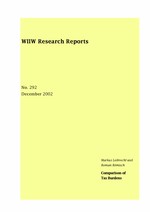Comparison of Tax Burdens
Markus Leibrecht and Roman Römisch
wiiw Research Report No. 292, December 2002
80 pages including 8 Tables and 3 Figures
Within the EU, taxation and the EU's eastern enlargement are currently seen as one of the most important problems to be solved and projects to be realized. Each of these two topics covers a vast set of issues which have to be dealt with. At the same time only few attempts have been made to answer those questions that arise if the two topics are combined what effects will EU enlargement have on taxation matters and how will EU tax regulations affect the accession countries economically.
In this study we try to answer the question which fiscal and non-fiscal economic effects one can expect in the case of EU eastern enlargement, solely on account of differences in the tax structures of the incumbent EU member states and the accession countries. The aim of this study is thus to (partly) fill the gap between EU eastern enlargement and tax-related aspects.
In answering that question we proceed as follows. We point up the differences in the tax structures and tax systems in the two blocs. This is done by using several measures of the `tax burden´ in the individual countries on the one hand, and by summarizing the past, current and future tax policy strategies of both the EU and the CEECs on the other. Then, by combining that information, we derive some economic implications that are useful for a broader discussion of our topic.
Keywords: comparative study, fiscal policy, integration, transitional economies
JEL classification: E62, E63, H2, P5
Countries covered: European Union, New EU Member States
Research Areas: Macroeconomic Analysis and Policy
